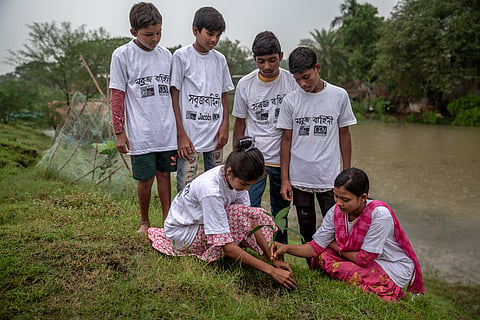Run-up to World Environment Day: How communities in coastal Bengal are turning the tide on climate change
Nestled between swelling rivers and meandering estuaries, an extraordinary movement is taking root in the lush green surroundings of South 24 Parganas, West Bengal — quite literally. In these climate-vulnerable villages, mothers with muddy hands, children with eager questions and communities with shared dreams are scripting a new chapter of resilience and hope.
Ask Maloti, a middle-aged mother from Patharpratima block and she will tell you that the Gobadhia river is both a lifeline and a threat. “Every year, we have floods. Gushing water enters our village and destroys everything,” she said, pointing to the embankment that shields her modest home from the saline fury. The memories of Cyclone Amphan in 2020 are still raw. The devastation it brought was a grim reminder of nature’s wrath intensified by climate change.
But Maloti and a group of determined women from Uttar Gopalnagar are no longer waiting for relief. Armed with saplings of garjan, garan and keora, they’re creating a natural shield — mangroves. These plants, known for stabilising coastlines and reducing erosion, are being nurtured by hand, one at a time, under the guidance of non-governmental organisation CRY’s (Child Rights and You) partner organisation, Kaajla Janakalyan Samiti. From collecting floating seeds during high tide to building their own nursery of 10,000 saplings, these women have built not just a forest but a movement.
What started as a community-led mangrove plantation has now evolved into an income-generating activity. Women are selling saplings to local NGOs and support groups, earning a small yet significant income. “We have to save the world for our children,” said Maloti, her voice steady with purpose. And it’s not just green fingers they’ve cultivated, it’s identity, empowerment and a stake in the future.
Young crusaders of change
While mothers guard the embankments, their children are championing change from classrooms and community halls. Seventeen-year-old Soumyadeep Bhuniya may not remember Cyclone Aila in 2009, but he knows enough from stories and the scars left behind. Raised in the storm-battered terrain of Patharpratima, Soumyadeep is now a Green Scout, going door to door to talk about tree plantation, personal hygiene and the dangers of plastic.
With support from Kaajla, over 300 children like him are enrolled in supplementary environmental education classes where they learn about climate change, the 3Rs (Reduce, Reuse, Recycle), rainwater harvesting and sustainable living. These classes are part of CRY’s broader effort to root environmental stewardship in the minds of the young. “What the children learn today, their parents will learn from them tomorrow,” said project coordinator Vivekananda Sahu.
The efforts are already bearing fruit — literally. In front of Raghunathpur Saraswati Free Primary School, a once-barren patch of land is now home to 300 fruit trees. Maintained by women’s self-help groups and monitored by Kaajla volunteers, the orchard is not only greening the area but also holds the promise of nutritional and economic benefits for the community.
In Mograhat, another part of South 24 Parganas, children like Riju Naik and Pallavi Naskar are dreaming of lighting up their future with the sun. As part of the project, science, technology, engineering and mathematics learning centres are training students in the science of renewable energy. Twice a week, about 120 children gather beyond school hours to explore solar energy, carbon emissions and how sustainability can start at home.
From switching off lights when leaving a room to telling parents not to use plastic bags, these children are applying their knowledge in everyday life. Their enthusiasm is infectious. “Initially, many children were not too keen on attending classes. But now, they bring their friends along,” said a teacher.
The project is particularly timely. As of now, 2024 stands as the hottest year on record. This conclusion is supported by multiple authoritative organisations, including National Aeronautics and Space Administration, National Oceanic and Atmospheric Administration, the World Meteorological Organization, the European Union’s Copernicus Climate Change Service and the United Kingdom’s Met Office.
United Nations' child rights body UNICEF has warned that nearly one billion children globally are at “extremely high risk” due to the climate crisis. West Bengal’s deltaic region — with its rising sea levels, saline ingress and shifting weather patterns — exemplifies this risk.
A green shield
The story of South 24 Parganas is one of compounding climate threats but also one of profound community action. The Banashree Mangrove Protection Committee, initially started by 17 local women, is further strengthening efforts by fencing mangrove plantations to protect them from fishing gear damage. The Gram Panchayats, forest departments and community-based organisations are joining hands in these green initiatives. Visual awareness campaigns, short films and mural painting projects are also in the works to expand the message.
What’s striking across these narratives is the generational synergy. Mothers, once confined to domestic spaces, are now community leaders and ecological guardians. Children, equipped with knowledge and curiosity, are influencing behaviours at home and beyond. Together, they form a resilient ecosystem — human and natural — that is learning to adapt, survive and thrive.
There’s still a long road ahead. Climate change is an ever-looming threat in this region where the land is low, the rivers are swollen and livelihoods precarious. But the actions being taken — by villagers with mud on their hands and dreams in their hearts — offer a model of localised, sustainable climate resilience.
Let us then draw inspiration from Maloti planting mangroves with her back bent and hope unbroken; from Soumyadeep knocking on doors with a tree sapling in hand; from Riju dreaming of a solar-powered schoolroom.
They are not just survivors. They are torchbearers. And through them, a battered land is learning to breathe, to resist and to believe again.
Trina Chakrabarti is Regional Director, CRY (East)
Views expressed are the author’s own and don’t necessarily reflect those of Down To Earth


